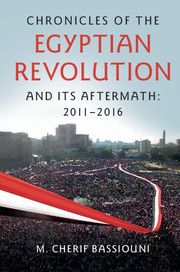Book contents
- Frontmatter
- Dedication
- Contents
- Preface
- Acknowledgments
- List of Abbreviations
- Introduction
- 1 The Early Stage of the Revolution
- 2 Mubarak Relinquishes the Presidency and the SCAF Assumes Power
- 3 A Prelude to Democracy: 2011–2012 Elections
- 4 The Morsi Presidency: June 30, 2012 to July 3, 2013
- 5 The Military's Return to Power and the El-Sisi Presidency
- 6 2015Legislative Elections and the Changing Civilian Political Landscape
- 7 The Military Institution: Its Power, Influence, and Culture
- 8 Violence and Repression
- 9 The Accountability Gap
- 10 The Justice System in Crisis
- 11 The Constitutional Quagmire
- 12 Demographics, Education, and the Economy
- 13 Geopolitical Factors
- 14 Concluding Assessment
- Pictures of the Egyptian Revolution and Related Events
- Bibliography
- Index
8 - Violence and Repression
Published online by Cambridge University Press: 24 November 2016
- Frontmatter
- Dedication
- Contents
- Preface
- Acknowledgments
- List of Abbreviations
- Introduction
- 1 The Early Stage of the Revolution
- 2 Mubarak Relinquishes the Presidency and the SCAF Assumes Power
- 3 A Prelude to Democracy: 2011–2012 Elections
- 4 The Morsi Presidency: June 30, 2012 to July 3, 2013
- 5 The Military's Return to Power and the El-Sisi Presidency
- 6 2015Legislative Elections and the Changing Civilian Political Landscape
- 7 The Military Institution: Its Power, Influence, and Culture
- 8 Violence and Repression
- 9 The Accountability Gap
- 10 The Justice System in Crisis
- 11 The Constitutional Quagmire
- 12 Demographics, Education, and the Economy
- 13 Geopolitical Factors
- 14 Concluding Assessment
- Pictures of the Egyptian Revolution and Related Events
- Bibliography
- Index
Summary
INTRODUCTION
In revolutions, violence and repression usually go hand in hand. Violence, unless defused, tends to escalate, and repression is more often than not one of its corollaries. Repression is believed, by those who have the power to engage in it, to be a way of controlling, limiting, and/or eliminating resistance by their opponents, irrespective of whether those who oppose the regime in power have a legitimate right to do so and of whether they act properly under the circumstances. As to the wielders of regime power, they deem that representing power is enough of a justification. They argue that their excessive use of power is warranted by the opponents’ failure to yield to them. But history records that sooner or later these policies and practices fail to accomplish their ends. Contrary to Mao Zedong's idea that “political power comes out of the barrel of a gun,” somehow, some way, legitimacy ultimately prevails, even if the human and material costs are high and the wait is long.
Violence and repression do not bring social peace and tranquility. More often than not, one leads to the other, though they do not always befall the same victims. Indeed, “Revolutions have never lightened the burden of tyranny: they have only shifted it to another shoulder.”
History proves that opposing sides tend to become deeply polarized, leaving little room, if any, for a balanced center. Each side clings to the belief that theirs is the one and only legitimate position and that the opposing side lacks legitimacy. Moderation and reason become the casualties of such situations.
As said by philosopher George Santayana, “Those who do not learn the lessons of the past are condemned to repeat it.”
Violence and repression need to be taken in the context of the events and with due relativity to the facts and circumstances of the times during which they occur.
CONTEXTUAL APPRAISAL OF VIOLENCE: 2011–2015
From January 25 to January 28, 2011, the Revolution was peaceful and nonviolent (Selmiya), as described in Chapter 1. Habib el-Adly, the infamous Minister of Interior under Mubarak, assessed what was happening in Tahrir Square as being limited and relatively insignificant. He first opted for containment and then for the forceful removal of the demonstrators from Tahrir Square.
- Type
- Chapter
- Information
- Publisher: Cambridge University PressPrint publication year: 2016

